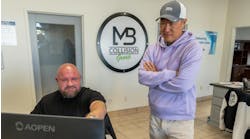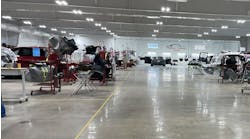The time has come for this argument to end.
Fact No. 1: Repair work ends at 150 grit. When you replace a welded-on panel, for example, the labor time clearly includes finishing only to 150 grit.
Fact No. 2: Paint times are for new, undamaged panels. A panel finished with 150 grit is not the equivalent to new and undamaged. To get to that level requires finishing to 320 grit.
Fact No. 3: Most paint and abrasives manufacturers concur that you should not jump more than two grit sizes. You can't go from 150 directly to 320 grit. It's that process in between the two that's "the gap."
Fact No. 4: The new Environmental Protection Agency (EPA) requirements that went into effect earlier this year require that all spray operations be conducted within a compliant spray booth or prep station by painters trained and certified in spray techniques and environmental compliance. This essentially mandates that "the gap" be filled by a painter, not a body tech, and as a refinish operation.
With those facts in mind, here are steps I recommend for those looking to be properly and justly compensated for the necessary steps in the process.
- Familiarize yourself with the written definition of the gap adopted by insurers and shops alike at the Collision Industry Conference (http://www.abrn.com/GapDefinition). "Feather, prime and block," that definition states in part, "are not-included refinish operations that complete the process from 150 grit to the condition of a new undamaged panel."
- Conduct and document some time studies. Want to know what you should charge for "the gap?" Videotape and time the process in your shop. Include all the necessary steps, including the time needed for the tech to gather the needed supplies, mix the primer, etc. The Automotive Service Association developed a packet of materials that can help you do this (http://www.abrn.com/ASAPacket). Do this 10, 20 or 30 times, and you will likely find a formula (a percentage of the total repair time) for the time that it requires, and you will have the documentation needed to back-up your formula
- Don't forget about the needed materials. Some insurers may argue that "feather, prime and block" is included in repair times. That makes no sense to me, especially given the EPA requirements for who conducts spraying operations and where. But even if you choose to include these refinish operations in your repair times, you should still be compensated for the necessary sandpaper, primer and other materials.
- Push the information providers. They argue that they can't automate a formula for "the gap" into their systems because there are too many variables. I would disagree based on the time studies I did in my own shop, and from the more than 100 such studies that ASA collected from shops nationwide. It's no different than the fiberglass boat repair times that one of the estimating system providers has developed where times are based on the dimensions of the damage. I can attest that we conducted dozens of "feather, prime and block" time studies in my own shops and found a consistent labor time associated with square footage.
Some shops may not want it to be automated, preferring to negotiate for it on their own. But at a minimum, a prompt in the estimating systems should ask estimators, anytime an estimate includes a repaired or welded-on panel, if they would like to add additional time for the feather, prime and block operations.
Mike Anderson is a former shop owner who operates http://CollisionAdvice.com, a training and consulting firm. He also is a facilitator for DuPont Performance Services' Business Council 20-groups. E-mail a question you'd like to have Mike address to [email protected].




